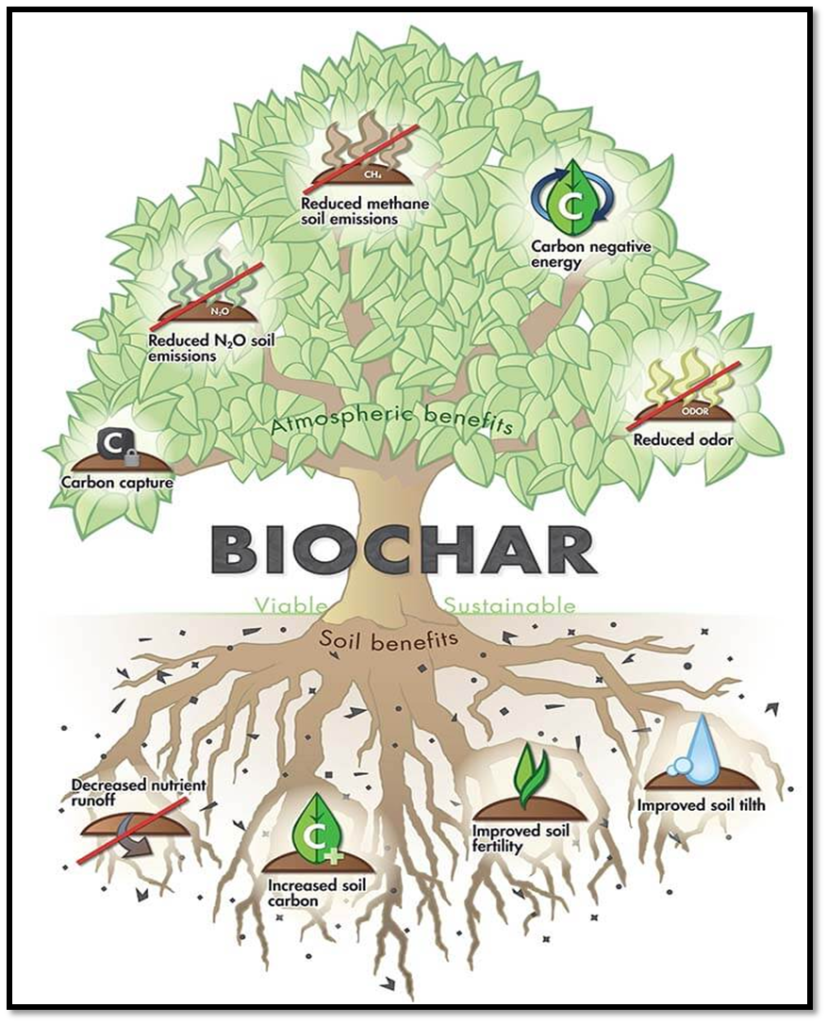Biochar is a stable solid, rich in carbon that is made from organic waste material or biomass (agricultural and forestry wastes) that is partially combusted in the presence of limited oxygen. It looks a lot like common charcoal.

Production of Biochar
Biochar is produced during pyrolysis, a thermal decomposition of biomass in an oxygen-limited environment. Wood chips, leaf litter or dead plants, are burned in a container with very little oxygen.
During the pyrolysis process, the organic material is converted into biochar, a stable form of carbon that can’t easily escape into the atmosphere. The energy or heat created during pyrolysis can be captured and used as a form of clean energy.
Biochar is by far more efficient at converting carbon into a stable form and is cleaner than other forms of charcoal.
Properties of Biochar
Biochar is black, highly porous, lightweight, fine-grained and has a large surface area.
Approximately 70 percent of its composition is carbon. The remaining percentage consists of nitrogen, hydrogen and oxygen among other elements.
Biochar’s chemical composition varies depending on the feedstocks used to make it and methods used to heat it.
Applications and role of biochar
Biochar may seem like a simple material, but it can help solve a variety of global problems simultaneously.

Combating soil degradation
Some of the ways that biochar may help improve soil quality include:
Enhancing soil structure
Increasing water retention and aggregation
Decreasing acidity
Reducing nitrous oxide emissions
Improving porosity
Regulating nitrogen leaching
Improving electrical conductivity
Improving microbial properties
Composting
Biochar is also found to be beneficial for composting, since it reduces greenhouse gas emissions and prevents the loss of nutrients in the compost material.
It also promotes microbial activity, which in turn accelerates the composting process. Moreover, it helps reduce the compost’s ammonia losses, bulk density and odor.
Carbon sequestration
The process by which biochar is manufactured may help sequester a billion tons of carbon annually and hold it in the soil for thousands of years, where it’s most beneficial.
Biochar production is a carbon-negative process, which means that it actually reduces CO2 in the atmosphere. In the process of making biochar, the unstable carbon in decaying plant material is converted into a stable form of carbon that is then stored in the biochar. When biochar is applied to the soil, it stores the carbon in a secure place for potentially hundreds or thousands of years, thus helping in carbon sequestration.
To put it simply, the feedstocks that were used for making biochar would release higher amounts of carbon dioxide to the atmosphere if they were left to decompose naturally. By heating the feedstocks and transforming their carbon content into a stable structure that doesn’t react to oxygen, biochar technology ultimately reduces carbon dioxide in the atmosphere.
Production of clean and renewable energy
During the production of biochar, clean and renewable energy is produced as a byproduct—this can be used as an alternative to burning fossil fuels, which has exacerbated global warming by adding greenhouse gases to the atmosphere.
Mitigation of climate change
Biochar also contributes to the mitigation of climate change by enriching the soils and reducing the need for chemical fertilizers, which in turn lowers greenhouse gas emissions. The improved soil fertility also stimulates the growth of plants, which consume carbon dioxide.
Other environmental benefits
Some of the of biochar include decreased groundwater pollution, lower cost of water filtration, reduced amounts of waste and higher profitability for farmers. This technology also contributes to food security by increasing crop yields and retaining water in areas prone to drought.
The many benefits of biochar for both climate and agricultural systems make it a promising tool for regenerative agriculture.
Must read: Conservation Agriculture – principles , benefits & problems
External link: http://www.climatehubs.usda.gov/hubs/northwest/topic/biochar#:~:text=Biochar%20is%20a%20stable%20solid,stalks%2C%20manure%2C%20etc.)
PRACTICE QUESTIONS
QUES . What is the use of biochar in farming? UPSC 2020
1 . Biochar can be used as a part of the growing medium in vertical farming.
2 . When biochar is a part of the growing medium, it promotes the growth of nitrogen-fixing microorganisms.
3 . When biochar is a part of the growing medium, it enables the growing medium to retain water for longer time.
Which of the statements given above is/are correct?
(a) 1 and 2 only
(b) 2 only
(c) 1 and 3 only
(d) 1, 2 and 3
Ans (d)
